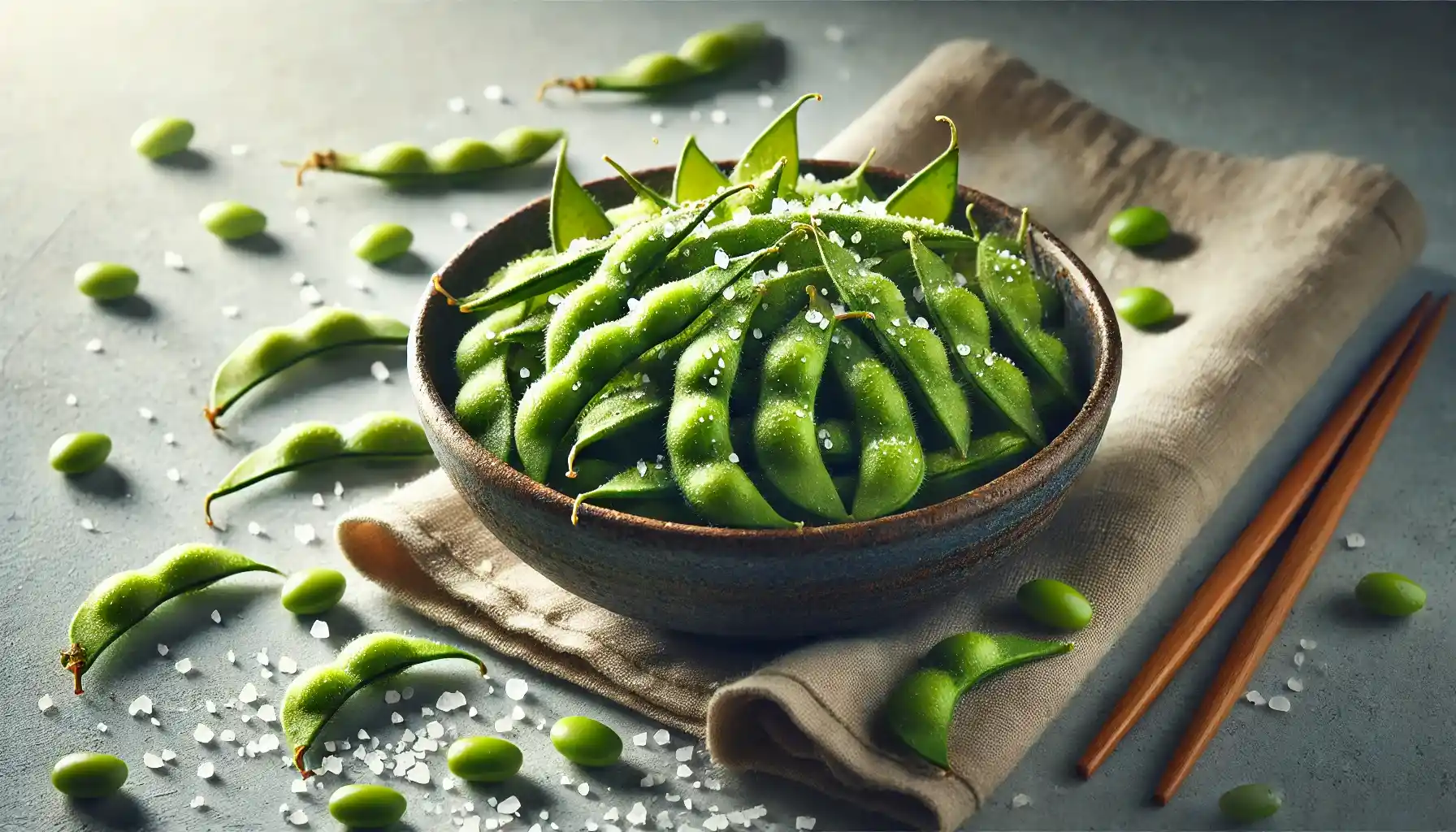Edamame, the young green soybean, is a favorite in kitchens worldwide due to its unique blend of nutty flavor, firm texture, and impressive nutritional profile. While it originated in East Asia, where it has been a staple for centuries, edamame has found a new audience in the West, especially among those seeking a healthy, plant-based protein. Often served as an appetizer in Japanese restaurants, edamame is a versatile ingredient that works well in various recipes, from salads to stir-fries. This guide will explore edamame’s origins, health benefits, nutritional profile, and provide recipes to help you incorporate this nutritious legume into your meals.
The Origins and Cultural Significance of Edamame
Edamame, which means “beans on a branch” in Japanese, has a long history in East Asia, especially in Japan and China. The first records of edamame date back over 2,000 years in China, where it was prized for its health benefits. In Japan, it became a summer staple, often served chilled with sea salt as a refreshing snack. Edamame is commonly enjoyed as an appetizer in izakayas (Japanese pubs), where it’s known for being both delicious and nourishing.
Today, edamame is loved globally for its nutritional benefits and versatility. With the growing interest in plant-based foods, edamame has become a popular choice in the West, valued for its health benefits and culinary flexibility.
Nutritional Profile of Edamame
Edamame is celebrated as a superfood due to its impressive nutritional profile. It’s one of the few plant sources of complete protein, containing all nine essential amino acids required for optimal health. Here’s the nutritional breakdown per 100 grams (about 1/2 cup) of shelled, boiled edamame:
- Calories: 121 kcal
- Carbohydrates: 8.9g
- Protein: 11.9g
- Fat: 5.2g
- Fiber: 5.2g
- Vitamin C: 9.5 mg (16% of the Daily Value)
- Vitamin K: 26 µg (33% of the Daily Value)
- Folate: 311 µg (78% of the Daily Value)
- Iron: 2.3 mg (13% of the Daily Value)
- Magnesium: 64 mg (16% of the Daily Value)
- Potassium: 436 mg (12% of the Daily Value)
Health Benefits:
- High in Plant-Based Protein: Edamame is an excellent source of protein, making it ideal for vegetarians, vegans, and those looking to reduce meat intake.
- Rich in Fiber: The fiber content in edamame supports digestive health, aids in weight management, and helps maintain stable blood sugar levels.
- Supports Heart Health: Edamame contains unsaturated fats and antioxidants that support heart health by lowering cholesterol levels.
- Loaded with Folate: Folate is crucial for cell growth and development, making edamame particularly beneficial for pregnant women.
- Boosts Immune System: Vitamin C and antioxidants in edamame boost immunity and help fight off free radicals.
- Good Source of Iron and Magnesium: Essential minerals in edamame support energy levels, muscle function, and bone health.
How to Cook Edamame
Edamame is simple to prepare and is typically served as a boiled, salted snack or used as an ingredient in recipes. Follow these steps for perfectly cooked edamame:
Ingredients:
- Fresh or frozen edamame in pods or shelled (1 cup)
- Salt (1-2 teaspoons for seasoning)
- Water (for boiling)
Cooking Steps:
- Boil the Water: Fill a medium pot with water and bring it to a rolling boil.
- Add Edamame: Add the edamame to the boiling water. For fresh edamame, cook for about 5-7 minutes. For frozen edamame, cook for 3-5 minutes.
- Drain and Season: Drain the edamame and sprinkle with salt while it’s still warm. You can enjoy the edamame in the pod by squeezing the beans out or use the shelled beans in recipes.
Delicious Edamame Recipes
1. Classic Salted Edamame
The simplest way to enjoy edamame is as a salted snack, a favorite in Japanese cuisine.
- Ingredients: 1 cup edamame in pods, sea salt to taste.
- Instructions: Boil edamame as directed above, drain, and season generously with sea salt. Serve warm or chilled.
2. Edamame and Avocado Dip
This green, creamy dip is a nutritious alternative to guacamole, loaded with protein and healthy fats.
- Ingredients:
- 1 cup shelled edamame
- 1 ripe avocado
- 1 clove garlic, minced
- Juice of 1 lime
- Salt and pepper to taste
- Fresh cilantro for garnish
- Instructions:
- In a food processor, blend the edamame, avocado, garlic, lime juice, salt, and pepper until smooth.
- Transfer to a bowl, garnish with cilantro, and serve with tortilla chips, vegetable sticks, or pita bread.
3. Edamame Salad with Quinoa and Veggies
This protein-packed salad is refreshing, filling, and perfect for a light lunch or side dish.
- Ingredients:
- 1/2 cup cooked quinoa
- 1 cup shelled edamame
- 1/2 cup diced cucumber
- 1/2 cup cherry tomatoes, halved
- 1/4 cup diced red onion
- Fresh basil or parsley for garnish
- 2 tablespoons olive oil
- 1 tablespoon lemon juice
- Salt and pepper to taste
- Instructions:
- In a large bowl, mix the quinoa, edamame, cucumber, tomatoes, and red onion.
- In a small bowl, whisk together the olive oil, lemon juice, salt, and pepper.
- Pour the dressing over the salad, toss to combine, and garnish with fresh basil or parsley before serving.
4. Garlic Sesame Edamame
For a savory twist, this garlic sesame edamame is perfect as a snack or appetizer.
- Ingredients:
- 1 cup edamame in pods
- 1 tablespoon sesame oil
- 2 cloves garlic, minced
- 1 tablespoon soy sauce
- 1/2 teaspoon sesame seeds
- Instructions:
- Boil the edamame in pods as directed, then drain.
- In a skillet, heat the sesame oil over medium heat. Add garlic and cook until fragrant.
- Toss the edamame in the skillet with soy sauce and sesame seeds, stirring until evenly coated. Serve warm.
Creative Ways to Enjoy Edamame
Edamame’s versatility makes it suitable for various recipes. Here are some additional ideas:
- Add to Stir-Fries: Toss edamame into vegetable stir-fries or noodle dishes for extra protein and texture.
- Include in Soups: Edamame can be a delightful addition to miso soup, ramen, or vegetable soups.
- Incorporate into Grain Bowls: Add a handful of edamame to rice or grain bowls with your choice of vegetables, greens, and a protein.
- Blend into Smoothies: For a protein boost, add shelled edamame to green smoothies along with spinach, banana, and almond milk.
- Use as a Pizza Topping: Sprinkle edamame on top of homemade pizza along with other vegetables and cheese for a unique twist.
Fun Facts About Edamame
- Ancient Superfood: Edamame dates back over 2,000 years and was historically praised for its health benefits in East Asian cultures.
- Eco-Friendly Crop: Soybeans, including edamame, are nitrogen-fixing plants that improve soil health, making them a sustainable crop.
- High in Complete Protein: Few plant foods provide all nine essential amino acids, making edamame a complete protein and an excellent choice for plant-based diets.
- Low in Carbs: Unlike many legumes, edamame is relatively low in carbohydrates, making it a suitable snack for those monitoring their carb intake.
Healthier Alternatives and Modifications
For those looking to further enhance the health benefits of edamame dishes, here are some tips:
- Use Less Salt: Reduce salt in recipes or replace it with herbs and spices for flavor without extra sodium.
- Add More Vegetables: Combine edamame with a variety of other vegetables for a more nutrient-dense meal.
- Try Baked Edamame Snacks: Bake shelled edamame with a bit of olive oil and seasoning for a crunchy snack alternative to chips.
- Opt for Organic Edamame: Choose organic edamame to reduce exposure to GMOs and pesticides.
Conclusion
Edamame is more than just a delicious snack; it’s a nutritional powerhouse with a rich history and cultural significance. Its versatility allows it to be used in a wide range of recipes, from salads and stir-fries to dips
and snacks. As a complete protein, it’s particularly valuable for those following vegetarian or vegan diets, providing essential nutrients like iron, folate, and fiber.
Whether you’re enjoying it the traditional way with a sprinkle of salt or experimenting with creative recipes, edamame is a fantastic ingredient to include in your diet. Its mild, nutty flavor and satisfying texture make it a hit for everyone, from health enthusiasts to casual snackers. So next time you’re looking for a nutritious and tasty addition to your meals, consider the humble edamame it’s sure to impress!




